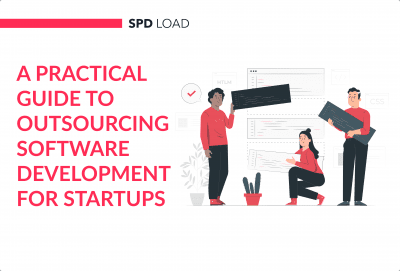Top 6 Educational App Ideas to Launch in 2025
- Updated: Aug 27, 2024
- 8 min
Struggling to come up with an innovative educational app idea for your startup that will impress investors and be scalable?
You’re not alone.
It can be challenging to create an educational app that meets the needs of students and teachers while standing out in a crowded market.
In this blog post, we’ll uncover the most promising education app opportunities for 2025 based on market gaps, emerging user demands, and demographic trends.
Whether you want to empower learners with disabilities, make studying fun through games, or build early childhood literacy skills, you’ll discover top app ideas across educational niches.
Check out our infographic for visual inspiration.
Curious about where app development is headed? Our application development trends guide has the answers.
Let’s dive into the top educational app ideas poised to make waves next year! Time to turn your creativity into a thriving startup.
Start your journey with our expert developers today to bring your app idea into reality!
Top Educational App Ideas to Launch in 2025
If you run an EdTech startup or plan to add an e-learning product idea to your catalog of projects, you can use this list of innovative elearning app development ideas to inspire your team.
1. Private Tutor Educational App
Nowadays, students are more interested in learning online. A private tutoring application helps them do just that by introducing them to online courses and tutors.
| Market demand | The demand for private tutoring applications is expected to be the nucleus of EdTech growth in upcoming years. The research credence to this belief suggests that the world’s private tutoring market is expected to reach $201.8 billion by 2026. The non-contact laws of the pandemic have also increased the need for tutoring applications. Founders who can create ideas and solutions to hasten this are going to enjoy mind-blowing growth. |
| Insights | Most successful educational applications partner with well-vetted teachers who can engage effectively online. Teachers are always willing to partner with these applications because it helps them earn faster and more conveniently. It’s a win-win situation for both teachers and students. As such, users can enjoy a top-notch user experience that can guarantee desirable outcomes for platform owners. |
| Examples | An EdTech startup with a product in this sphere is Coursera. Coursera is a platform that enables tutors and students to interact through a best-match algorithm. Coursera is a U.S.-based EdTech company that was created by Daphne Koller and Andrew Ng. |
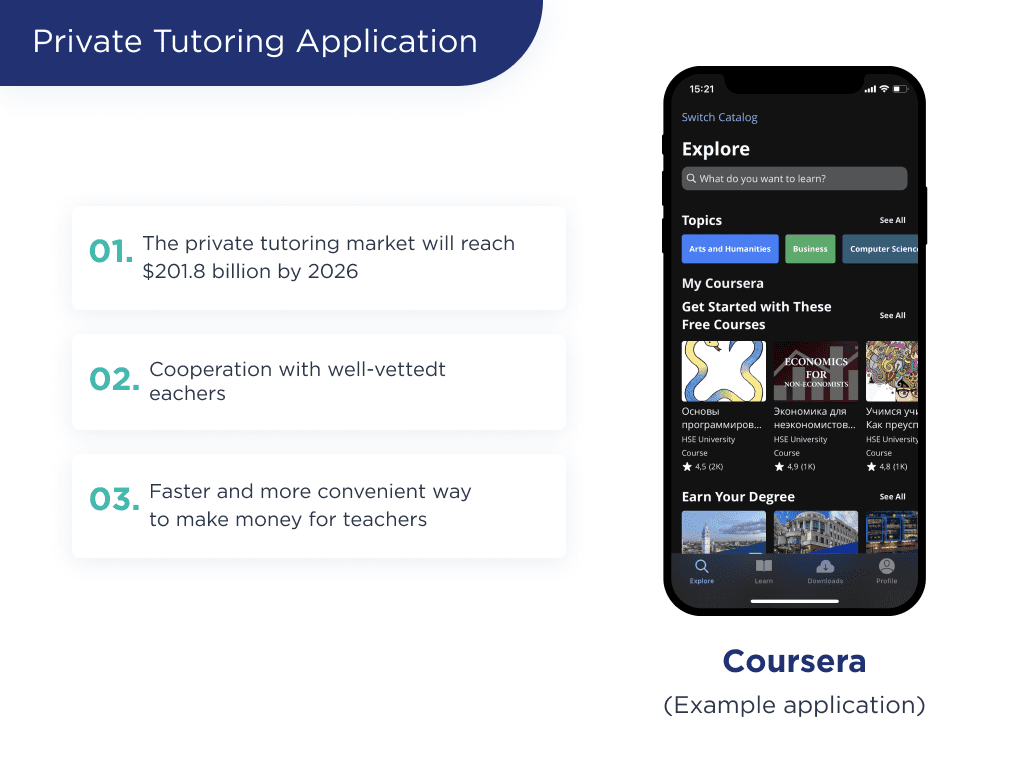
2. Apps for Individuals With Learning Disabilities
Individuals with learning disabilities require a lot of support to learn.
When these kids attend regular schools, they often encounter numerous learning difficulties. To ease their learning, they need educational apps that are tailored to their needs.
| Market demand | Statistics from the CDC show that 1 in 54 kids in the US is born with autism spectrum disorder. According to the United States B.L.S., the demand for special educators is expected to grow by 8% in 2026. This means that more opportunities in this field are expected to open up soon. Such educational apps are already keying into this demand gap. |
| Insights | Parents of autistic kids need to teach their kids how to communicate effectively at an early age. As such, most of them turn to apps that appeal to this need as they offer a cheaper way out. These apps are built to fascinate autistic kids, as a result, they’ll study in a fun way. Parents also prefer to teach their kids through such educational applications since it eases teaching and gives them enough time to focus on other productive activities. This type of platform is effective because it only links users with qualified help in real-time. Only tutors with qualifications and experience teaching individuals with learning disabilities are often allowed. Furthermore, as these apps often require internet access, it’s essential to be aware of online safety for children with learning disabilities to ensure a secure learning environment. |
| Examples | An example of an application in this category is ModMath. ModMath is the first free iPad application designed to help kids with dysgraphia and dyslexia. Another educational solution tool in this category is Autism iHelp. It’s a simple application to help kids with autism express themselves. Another helpful platform is Autism Education. |
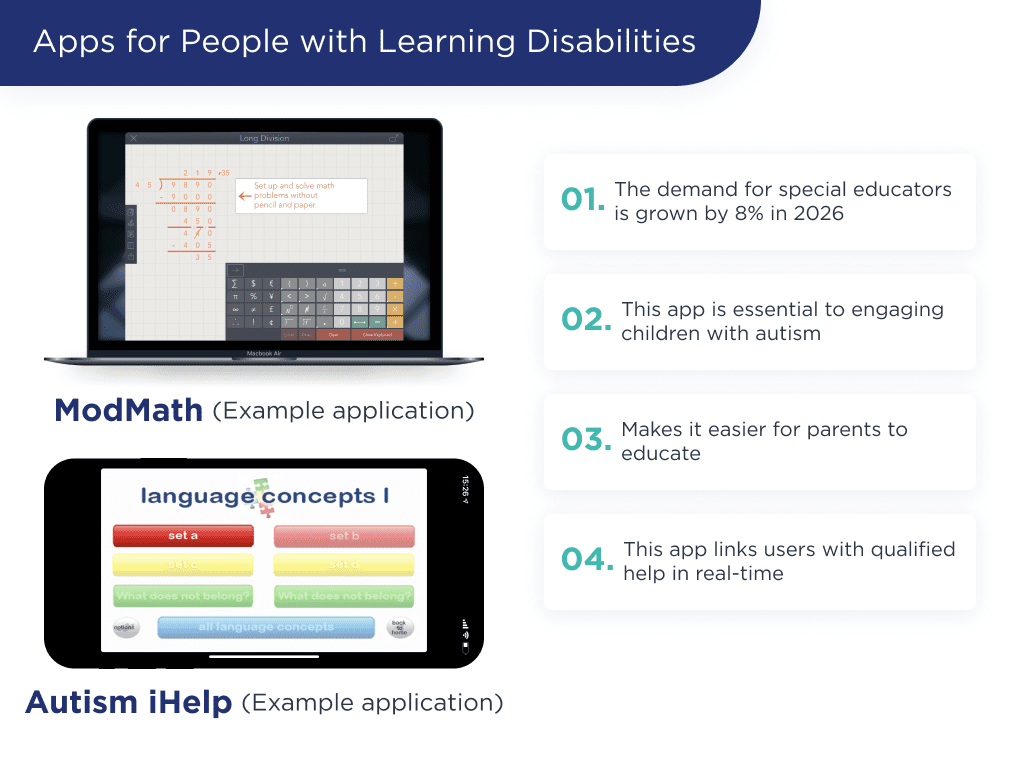
3. Quiz and Game Apps
Most kids perceive studying as a mundane and tiresome task.
However, inculcating education with games makes kids interested in learning.
Games and quiz educational apps can’t act as core tools for learning; tutors only use them as supporting tools.
| Market Demand | Based on statistics from Gamesandlearning.org (graph shown below), the demand for digital games and quizzes for learning is enormous. A survey suggests that over 55% of students play educational games weekly. And from the chart below, it’s safe to assume that this method has already gained popularity in most schools. As such, schools are willing to promote solutions that can come up with engaging games and quizzes. |
| Insights | Statistics show that more than 93% of kids already love playing video games. As such, it’s not wishful thinking to say that Quizzes and Games can offer some of the most captivating ways to learn. By making learning a game, learners will find it more appealing. Parents and teachers can also dedicate less time to teaching, as the kids will most likely be engaged in the fun learning process. A gamified education app offers a rare opportunity to eradicate the popular notion that learning is tiresome. |
| Examples | An example of a successful school application to create your idea from including MentalUP Educational games Other notable examples include Toca Blocks, Thinkrolls, Endless Alphabet, etc. Learn more on how to create a successful app. |
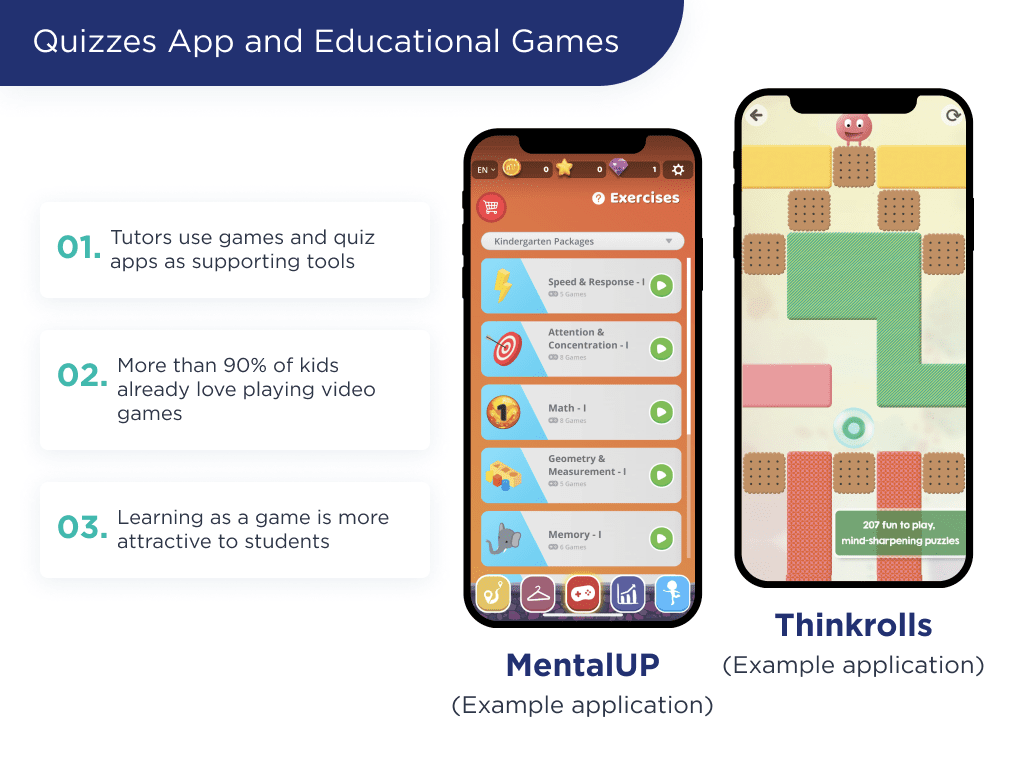
4. Dictionary App
The world is going digital. Gone are the days when students carried huge dictionaries in their bags.
Most students now prefer to have a dictionary on their phones as it is more convenient.
| Market Demand | Thinking of developing an e-learning dictionary app as a startup? Then you should take some statistics into account. The first is that revenues from the Apple App Store are often 50% higher than those from the Google Play Store. As such, if you’re considering launching your product on either platform, the Apple App Store is the best option. However, the country that uses your product also determines which store to prioritize. Why? This is because some countries use certain application stores more. For example, Japan and South Korea use Google PlayStore more than any other country. Thus, a dictionary application in Korean or Japanese must be on Google PlayStore. In terms of revenue, Germany, South Korea, and Japan are the best places to target for dictionary ideas. As such, you should make a bilingual dictionary solution that can cater to that demand. |
| Insights | Another reason why people prefer dictionary applications as educational resources is that they offer more features than the traditional paper dictionary. Dictionaries applications now offer vocabulary, translation, glossaries of terms, and other unique features to improve users’ experience. |
| Examples | An already existing dictionary app from which to pick your education app ideas includes Dictionary.com. The platform allows users to browse offline and also has some exciting features. It has more than 2,000,000 definitions and synonyms. It also features audio pronunciations and “Word of the Day.” |

5. Language Learning App
Language learning applications are educational apps created to help users familiarize themselves and become fluent in a new language.
| Market Demand | The growing interest in online learning platforms has increased the number of learning language applications. As a startup, this is the most profitable time to jump right into the market. Here are some statistics that suggest that building a language platform right now is a very profitable move:
|
| Insights | Learning apps are tools for learning a foreign language. Globalization has increased people’s desire to learn new languages. To meet the insatiable demand for knowledge of new languages, people are now seeking language learning solutions on the Internet. People prefer this way of learning because it allows them to learn on the go. Some apps also have an online community with which users can communicate. This engages users with the native speakers of the language they’re learning. Considering those stats and reasons above, it’ll be unwise to ignore education app ideas on language learning apps. |
| Examples | Here are some examples of leading language e-learning applications that you can draw your ideas from:
|

6. Preschool App
As the name suggests, preschool apps are designed to help kids who are about to start schooling.
| Market Demands | Based on research by Common Sense Media, over 25% of parents have preschool apps. Teachers also use this application to teach preschool courses to kids. The interest of kids, parents, and teachers in preschool multiplied by apps gives limitless opportunities for Startups. As an education startup, if you’re thinking of developing a preschool educational app, you can target parents or teachers in your marketing strategy. |
| Insights | Kids love to learn. Creating a preschool app gives parents a cheaper way to teach their kids. What’s more? Preschool EdTech platforms also help kids learn faster; as such, there’s a high demand for them among parents. These applications are built with the interest of kids in mind. Developers inculcate certain elements that kids find amusing. For example, most preschool platforms feature cartoon characters and songs that young ones find captivating. |
| Examples | Top preschool e-learning platforms to draw your app-building inspiration from include:
|
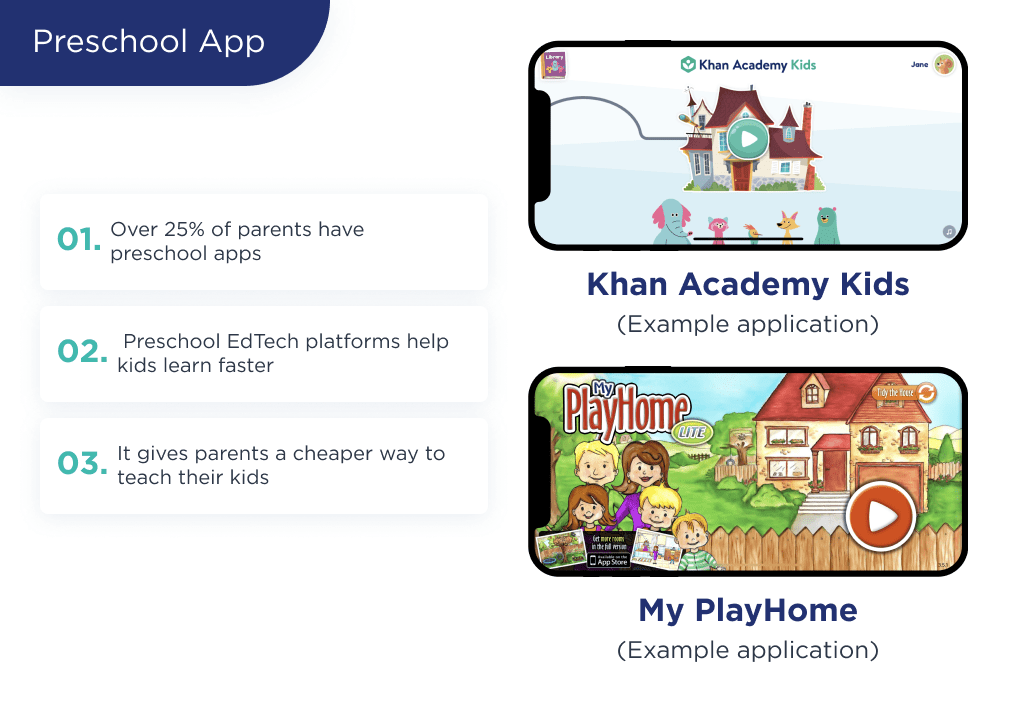
How to Develop Educational Apps That Enhance Learning Experiences?
Designing and developing an educational app is a fulfilling task that is underscored by some essential practices to ensure the impact that it can create for users. Not only immediately but also because it has been in the digital realm over the long term.
It starts with research.
You need to understand your end users and their needs. This helps determine what functionality is important in your future education app.
Then, consider why you would want your education app created and who will be taking action to engage with it.
Create unpolished drafts of the visual interface so you can visualize what it’s doing. During the app design process, keep it clean and user-friendly. Users are drawn to simple, easy-to-use designs. It helps them flow through the app.
At this stage, what we are trying to do is to match the app with the right tool or technology.
This is where the code of the application gets written, and its purpose is to create a perfect connection between the front and back end of the application.
Once the educational app is created, it’s time to test. We make sure everything flows smoothly, and there aren’t any glitches or issues that will hamper the experience of the users.
Launching the app is another vital stage.
Do a good amount of promotion of the unique features of your application.
After launching, be attentive to the users by listening to their feedback, which help you in further improvement. Keep updating the application to keep it up to date with the advancement in technology.
Also, if good customer service isn’t maintained, users will lose interest in the application and will not use it. Help them when they face any problems.
So, if you take these steps, it will give you an engaging educational app that is not only operational but also helps students learn with fun.
Ready to Bring Your Educational App Ideas to Life?
The edtech potential in 2025 is astounding. With the right educational app ideas and sharp execution, you can positively shape learning for new generations.
But success takes more than app ideas alone.
You need a proven education app development team to help craft product strategy, spearhead development, and grow hack distribution so students can use your education app.
Our edtech agency can be that tech partner. We have nearly a decade of award-winning expertise in building, launching, and scaling innovative educational apps for leading K-12 brands and well-funded startups.
Ready to discuss how we can turn your app ideas for students and teachers into reality with our e-learning app development services? Let’s talk! Together, we can develop the next big thing in education.
Bonus Infographic
Here, you’ll find the summary infographic. Explore the highlights to learn more about innovative ideas for education apps. 










